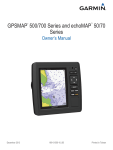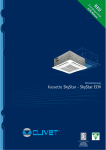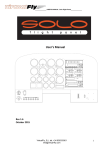Download The GPS Smart Coupler II Installation/User Manual
Transcript
The GPS Smart Coupler II Installation/User Manual Porcine Associates 244 O’Connor Street Menlo Park, CA 94025 (650) 326-2669 Fax (650) 326-1071 www.porcine.com 3.13 Table of Contents THE GPS SMART COUPLER II USER MANUAL 1 Smart Coupler II Description What is it? Smart Coupler Choices How does it work? What does it do? Guarantee 1 1 1 2 3 4 Smart Coupler Installation Mechanical installation Electrical connections Course Width Selection Installation check - Smart Coupler II (the LE version is treated separately below) Installation check - Smart Coupler LE 4 4 4 8 8 9 Smart Coupler Use Course Mode Normal procedure Heading Mode Normal procedure Intercept Mode Normal procedure 10 10 11 12 Specifications (apply to both models unless noted) Power Enclosure Autopilot output Serial input GPS OK output 13 13 13 13 13 13 APPENDIX I - GPS RECEIVERS GPS Receivers and requirements Dec 6, 2000 15 15 page i Table of Contents APPENDIX II - TROUBLESHOOTING 17 1.0 Start Here 17 2.0 Indicators Blink on power-up 17 3.0 Valid Status stays on when GPS is connected 17 4.0 Ailerons go to full lock 18 5.0 Ailerons will center with trim knob 18 6.0 Flies in circles 18 7.0 CDI centered before engaging autopilot 19 8.0 CDI not centered 19 9.0 Aircraft does not fly in circles 19 10.0 Ailerons will not center with trim or 11.0 Ailerons do not go to full lock 19 12.0 All indicators blink on power-up but otherwise stay off. 12.1 GPS data turned off 12.2 Data cable not wired correctly 12.3 GPS receiver has no course programmed 12.4 GPS receiver has not acquired the minimum number of satellites 12.5 GPS receiver does not append the NMEA checksum to its data stream 20 20 21 22 13.0 All indicators do not blink on power-up 22 APPENDIX III 22 23 Features: page ii 22 23 Dec 10, 2000 19 GPS Smart Coupler User Manual Factory settings: 23 When should I change these settings? Course Width Night brightness 23 23 24 How to set the Smart Coupler II (with 3 buttons) Night Dimming Course Mode course width Heading Mode course width 25 25 25 26 How to set the Smart Coupler II LE (with 1 switch) Night Dimming Course Mode course width Heading Mode course width 27 27 27 28 To set any parameter using an IBM-PC Required tools Setup instructions 29 29 31 Dec. 10, 2000 page iii The GPS Smart Coupler II User Manual Smart Coupler II Description What is it? The Smart Coupler II is a device that allows your aircraft autopilot to follow a global positioning system (GPS) course or track generated by a hand-held or panel-mounted GPS receiver. Your wing-leveler type autopilot can now have course mode, heading mode and intercept mode just like the big boys – without the expense and weight of a directional gyro (DG) with a heading bug. In course mode, the autopilot will follow the course previously placed in the GPS receiver. Autopilots that do not use a heading bug can follow multi-segment courses with no intervention from the pilot. Some autopilots that use a heading bug in navigation mode require that you move it to the new heading at each waypoint. In heading mode, the autopilot will keep your aircraft on a constant ground track independent of winds. No DG is required for heading mode. All information is derived from the GPS receiver. To engage heading mode, turn your aircraft to the desired heading, wait about 10 seconds for the GPS receiver to calculate your new ground track, then push and hold the heading mode button for about 1/2 second. Once in heading mode, you can skew your desired heading left or right by tapping the course or heading buttons on the Smart Coupler. Your heading will change by one degree for each tap. In intercept mode, the autopilot will keep your aircraft on a constant heading until you cross the course previously placed in the GPS receiver. When you cross the course, the Smart Coupler will switch to course mode and turn your aircraft to follow the course. Smart Coupler Choices There are two models from which to choose. The Smart Coupler II P has a control panel that is 1 1/8”H x 3 3/16”W. The processor Dec 6, 2000 page 1 GPS Smart Coupler II User Manual enclosure is attached and requires a 1 1/32”H x 2 5/16”W hole behind the control panel. This model has all three modes – Course, Heading and Intercept. The control panel has four LED indicators and three push-button mode switches. The Smart Coupler II LE is identical except that it is optimized for mounting in aircraft with limited panel space. Its control panel is only 3/4” x 3/4”. The processor enclosure is remotely mounted and connected to the control panel with a supplied 24” cable. The LE model has Course and Heading modes but not Intercept. Its control panel has a single two color LED and a single center-off toggle switch that is pushed left or right to change modes or to skew in heading mode. How does it work? To make this work you connect your GPS receiver to the Coupler, then connect the Coupler to your autopilot. Your autopilot must have a VOR or other tracking input and the GPS receiver must have a data port that is capable of transmitting data in one of two formats. The first is National Marine Electronics Association (NMEA) 183 Version 1.5 or 2.0 standard sentences GPRMB and GPRMC. The second is Aviation format data, sometimes called Argus data. All new and many old GPS receivers meet this requirement. See Appendix I for a list of receivers that are known to work with the Smart Coupler. If you have other tracking sources for your autopilot you must add a switch to select among the various sources. For example, you may have a primary VOR, a secondary VOR and a Loran receiver already installed. In this case you will need a two pole, four position switch to add your GPS receiver to the possible choices. There are only five wires to connect to your aircraft: • • • Power and ground A connection to your Navigation lights Two wires to the autopilot The panel lamps dim automatically when you turn on the navigation lights. page 2 Dec 10, 2000 GPS Smart Coupler II User Manual What does it do? The Smart Coupler II listens to the serial output of a GPS receiver, extracts the left-right navigation information and makes an analog signal that is suitable for an external course deviation indicator (CDI) or autopilot input. The coupler can decode any GPS serial output that transmits NMEA or Aviation format data. The specific NMEA sentences that are translated are GPRMB and GPRMC. The Smart Coupler II can produce a course width of 1.25, 2.5, 5 or 10 NM. This corresponds to 0.25, .5, 1 and 2 NM per dot on a normal course indicator. GPS course width does not depend on distance from a waypoint. The course width is fixed on installation. Normally, course width can be left at 1.25 NM (factory default). Autopilot course width is independent of the course width selected for your GPS receiver’s built-in CDI. The two models behave slightly differently to indicate that the GPS receiver is ready and sending information to the Smart Coupler. For the Smart Coupler II P (not LE), any time it receives valid course information from the GPS receiver it turns on the leftmost green LED to indicate that it is ready for the pilot to select course, heading or intercept mode. The LE, since it has no GPS OK LED, rapidly flashes its two color LED if you try to select a mode and the information to support the selected mode has not been received from the GPS receiver. If the Smart Coupler does not receive a new navigation value from the receiver for approximately 30 seconds, it centers the autopilot output, turns off the green status indicator and cancels any selected mode. When the coupler is turned off or if the coupler is not receiving valid left–right course information, the autopilot output is at 0 volts with respect to the reference. When the coupler is receiving course information from the GPS receiver, it drives the autopilot output in the range of ±150mv. The output is 0 volts when on course. It is plus or minus 150 mV when off course for the full course width and proportional in between. A minus output indicates right of course (turn left to get back to course). Some avionics manufacturers refer to these signals as +Right Deflection and +Left Deflection. See table 1 and figure 1 below. Dec. 10, 2000 page 3 GPS Smart Coupler II User Manual Both models have provision for an external GPS OK indicator. The output is an open collector switch to ground. This output can also be wired to the data OK flag on an HSI. Call Porcine Associates for details if you intend to connect the Smart Coupler to an HSI. Guarantee Return the Coupler within 90 days for a full refund if you are not completely satisfied. It the Coupler does not work with your Aviation or NMEA-183 data compliant GPS receiver, either return the Coupler for a refund or let us borrow your receiver and we will make it work with the coupler. In order for the Coupler to work properly, the NMEA receiver must transmit both sentences GPRMB and GPRMC. Smart Coupler Installation Mechanical installation Avoid placing the Coupler closer than 24 inches from a transmitting antenna. There is some confusion as to how to orient the LE panel. When installed, the LED is on top with the switch on the bottom. The “course” label is on the left and the “heading” label is on the right. In this orientation, when in heading mode you will push the toggle to the left to skew your course left and push the toggle to the right to skew right. The pictures in an early brochure were incorrect. Electrical connections Refer to Figure 1 and Table I below for the Smart Coupler connector pin-out and signal names. The coupler must be protected with a 1 amp fuse or circuit breaker. The coupler can be left powered all the time or can be fed from a switched source such as the autopilot on–off switch or avionics master. Current draw is negligible, less than 50 ma. The pinout of the DB9 connector on the rear of the Smart Coupler chassis is shown below for reference. In a normal installation only the five pigtails from the pre-wired harness are used. For 28V aircraft there is an internal jumper that must be cut. This will be done by the factory if you ordered a 28V unit. The jumper is located next to the DB9 connector on the internal PWB. page 4 Dec 10, 2000 GPS Smart Coupler II User Manual Connection to GPS There is a five position DIN panel connector pre-wired in the Smart Coupler harness that can be used to connect to your GPS receiver. The mating connector is supplied with the coupler. You must buy the power/data cable that plugs into your GPS receiver from the manufacturer of the receiver. Terminate this cable with the supplied DIN connector. Consult your GPS manual for the pin out and signal names of the serial output. There is an additional red wire that is by itself in the harness. This can be optionally connected to an external GPS OK indicator. The indicator should be wired between the red wire and +14V (+28V). The Coupler will sink up to 100ma to light the indicator. You may choose not to use this wire as the Smart Coupler II has a GPS OK indicator on its panel while the LE will blink the two-color LED rapidly several times if you try to select a mode when the data is not available. This wire can also be used to connect to the data OK flag in an HSI. Call Porcine Associates for details. The yellow wire senses the voltage going to the navigation lights. If the sensed voltage is less than 2.5V the Smart Coupler panel lamps are bright. If more than 2.5 volts the Smart Coupler panel lamps are dimmed. The yellow wire must be grounded if not used. Connection to autopilot Consult the autopilot manual for appropriate connections. Dec. 10, 2000 page 5 GPS Smart Coupler II User Manual Red GPS OK** Blue Black Smart Coupler II Chassis GPS Connector (DIN) +12V 1 Data 2 Gnd 3 +12V Gnd Yellow Nav lights* Red +R To Autopilot Black +L *Connect to ground if not used **Leave unconnected if not used Figure 1 Connections to pre-wired Smart Coupler harness pin 1, 6 2, 3 4 5 7 8 9 description Aircraft ground (1 and 6 are connected internally) Aircraft power (2 and 3 are connected internally. Select 24V by cutting internal jumper.) +Left Autopilot Output (to autopilot) Navigation lights input (see note below*) GPS OK Status (see note below**) +Right Autopilot Output (to autopilot) NMEA 0183 data input (from receiver) Table 1 Smart Coupler chassis connector pin out Notes: *Connect to ground if not used. This will make the lamps bright. **Leave unconnected if not used. page 6 Dec 10, 2000 GPS Smart Coupler II User Manual pin 1 2 3 4 5 description GPS receiver power (+14V to receiver, see note below*) Data output (from receiver) Aircraft ground Unused Unused Table 2 GPS receiver DIN panel connector pin out *The GPS power wire is wired directly to the blue +14V power wire in the Smart Coupler II harness. This will not work to power a 14V handheld in a 28V aircraft. Other provisions must be made to supply proper voltage to the handheld. Note that the DIN panel connector pins are numbered 1-4-2-5-3 clockwise looking at the front of the panel connector. Pin one is at the 9:00 o’clock position if you hold the connector so that the single chassis ground recess is at the bottom while the 5 other recesses are arrayed at the top from 9:00 O’clock through 12:00 O’clock to 3:00 O’clock. 2 4 1 5 3 Pin numbers looking at front of panel connector There is an additional red wire that is by itself in the harness that can be optionally connected to an external GPS OK indicator. The indicator should be wired between the red wire and +14V (+28V). The Coupler will sink up to 100ma to light the indicator. You may choose not to use this wire as the Smart Coupler II has a GPS OK indicator on the panel while the LE will blink the two-color LED rapidly several times if you try to select a mode when the data is not available. This wire can also be used to connect to the data OK flag of an HSI. Call Porcine Associates for details. Dec. 10, 2000 page 7 GPS Smart Coupler II User Manual Course Width Selection Normally, the course width is left at 1.25 nautical miles. This means that if the GPS receiver signals the coupler that the aircraft is one and a quarter miles right or left of course, the coupler will output –150 mV or +150 mV respectively. If course width is set to 10, the coupler will output 150 mV for ten miles off course. Course width can be set to 1.25, 2.5, 5 or 10 nautical miles. Course width affects system gain when the autopilot is in any navigation mode. A course width of 1.25 has four times the gain of a course width of 10. Normally you choose the narrowest course width that the autopilot will follow and still be stable. If your autopilot is nice and stable when not coupled to the GPS but overshoots the course or continuously banks left and right after coupling, it usually means the gain is too high. Try increasing the course width. Course width is set by pressing the buttons in a special sequence when power is applied to the Smart Coupler or by sending a special calibration sentence to the Smart Coupler II. See appendix III for details. The maximum voltage from the Smart Coupler is 150 mV. If the aircraft is more than the selected course width off course, the Smart Coupler will send full scale – either plus or minus 150 mV. Installation check - Smart Coupler II P (the LE version is treated separately below) After the installation is completed, you can quickly check if the Coupler is receiving and decoding information from the GPS receiver. 1. Turn on the GPS receiver and put in a course from the present position to a nearby waypoint. 2. Enable the serial output to the Coupler. 3. Apply power to the Coupler. 4. After the receiver has acquired the minimum number of satellites, the Coupler leftmost, green GPS OK LED should light. There should be 0±1 millivolts difference between the wires connected to page 8 Dec 10, 2000 GPS Smart Coupler II User Manual the autopilot. If you have a wing leveler type of autopilot and if you enable the autopilot in tracking mode, you should be able to center the ailerons with the trim knob. 5. Once the GPS receiver has acquired its satellites, press the course mode button on the Smart Coupler II chassis for 1/2 second. The associated yellow LED will light. Once the receiver is ready there should still be less than 1mv difference in the two wires going to the autopilot. 6. Now enter a course such that your present position is at least 1.25NM (or whatever you have selected as course width) off course. 7. The Coupler green GPS OK LED should still be on. Press the course mode button for 1/2 second. The associated yellow LED will light. If the receiver was ready, there should be 150±10 mV difference between the wires going to the autopilot. The ailerons should move to steer the airplane toward the course. 8. Turn off the GPS receiver but leave the power applied to the Coupler. 9. After approximately 30 seconds, both Coupler LEDs will go off. The ailerons should go back to center. 10. This completes the installation check. See appendix II for a complete troubleshooting guide. Installation check - Smart Coupler LE After the installation is completed, you can quickly check if the Coupler is receiving and decoding information from the GPS receiver. 1. Turn on the GPS receiver and put in a course from the present position to a nearby waypoint. 2. Enable the serial output port from the GPS receiver to the Coupler. 3. Apply power to the Coupler. The LED will alternately flash green and yellow several times. 4. Try to select course or heading mode before the GPS receiver has acquired its minimum number of satellites. Do this by holding the switch to the left or right for 1/2 second. The LED will rapidly Dec. 10, 2000 page 9 GPS Smart Coupler II User Manual flash alternately green and yellow, then go off. There should be 0±1 millivolts difference between the wires connected to the autopilot. If you have a wing leveler type of autopilot and if you enable the autopilot in tracking mode, you should be able to center the ailerons with the trim knob. 5. Once the GPS receiver has acquired its satellites, press the Smart Coupler II LE mode switch to the left for 1/2 second. This selects Course mode, where the Smart Coupler passes CDI information from the GPS receiver to the autopilot. The LED will glow green. There should still be less than 1 mV difference in the two wires going to the autopilot. 6. Now enter a course such that your present position is at least 1.25NM (or whatever you have selected as course width) off course. 7. Again hold the switch to the left for 1/2 second to select Course mode. The LED will again glow green if the receiver is ready. There should be 150±10 mV difference between the wires going to the autopilot. The ailerons should move to steer the aircraft toward the course. 8. Turn off the GPS receiver but leave the power applied to the Coupler. 9. After approximately 30 seconds, the Coupler LED will go off. The ailerons should go back to center. 10. This completes the installation check. See appendix II for a complete troubleshooting guide. Smart Coupler Use Course Mode Normal procedure • Put a course in to the GPS receiver. • Enable the NMEA 183 output from the receiver. Ensure the receiver is not in battery saver mode. • Fly your aircraft to place it on course and on the correct heading. Use the CDI in the GPS receiver to help do this. page 10 Dec 10, 2000 GPS Smart Coupler II User Manual • If your model has a GPS OK indicator, note that it is lighted. This indicates that the Coupler is receiving and decoding course information. • Press the Course button for 1/2 second. Note that the associated green LED comes on. If the LED blinks rapidly several times, then goes off, it means that the Smart Coupler is not receiving valid information from the GPS receiver. • Enable your autopilot in tracking mode. • Relax! Heading Mode Normal procedure • Enable the NMEA 183 output from your GPS receiver. Ensure the receiver is not in battery saver mode. • If your model has a GPS OK indicator, note that it is lighted. This indicates that the Coupler is receiving and decoding course information. • Fly your aircraft on heading for about 10 seconds to allow the GPS receiver to calculate your ground track. • Press the Heading button for 1/2 second. Note that the associated LED comes on (yellow on both the Smart Coupler II and on the LE). If the LED blinks rapidly several times, then goes off, it means that the Smart Coupler is not receiving valid information from the GPS receiver • Enable your autopilot in tracking mode. • Relax! • Minor heading changes can be made by tapping the left and right buttons on the Smart Coupler II (push the toggle left or right on the LE). Your target heading will skew about 1 degree for every tap. Dec. 10, 2000 page 11 GPS Smart Coupler II User Manual Intercept Mode Normal procedure This mode is not included in the LE version of the Smart Coupler • Put a course into your GPS receiver. • Enable the NMEA 183 output from your GPS receiver. Ensure the receiver is not in battery saver mode. • Note that the GPS OK indicator is lighted. This indicates that the Coupler is receiving and decoding course information. • Turn your aircraft so that you are on a heading that will intercept the GPS course with a closing angle of about 30 degrees. Fly your aircraft on this heading for about 10 seconds to allow the GPS receiver to calculate your ground track. • Press the Intercept button for 1/2 second. Note that the associated yellow LED comes on. • Enable your autopilot in tracking mode. • Relax! • When your aircraft crosses the GPS course, the Smart Coupler will switch from heading mode to course mode and turn your aircraft to follow the course. The mode LEDs will change to indicate when the switch is made. • Until you cross the GPS course, minor heading changes can be made by tapping the left and right buttons on the Smart Coupler II. Your target heading will skew about 1 degree for every tap. Note that the sensitivity of the CDI built into the GPS receiver is separate from the course width that the Smart Coupler sends to the autopilot. Many GPS receivers allow you to set the sensitivity of the built in CDI. The autopilot output course width always remains constant. page 12 Dec 10, 2000 GPS Smart Coupler II User Manual Specifications (apply to both models unless noted) Power • Voltage: 7-16V DC or 14-32V DC (jumper select), current: 50mA. Enclosure Controls Enclosure Mounting Material, weight Smart Coupler II P Smart Coupler II LE 3 3/16”W x 1 1/8”H 3/4”W x 3/4”H 2.4”W x 1”H x 2.3”D 2.4”W x 1”H x 2.3”D Through panel Behind panel Fire resistant ABS plastic box, UL94-V0, 3.5 ounces Autopilot output • • • • • • Differential analog signal. ±150mv full scale (selectable 1.25,2.5 5 or 10 NM off course). Not referred to ground. Positive means turn right to return to course. The transmitted output is cross-track error. This is an analog signal that represents the shortest distance from the current position to the selected ground track. There is a simple one-pole filter on the autopilot output with a time constant of approximately two seconds. No other filtering or integration is done in the Smart Coupler. Serial information is translated to analog information and immediately transmitted. Serial input • • Designed to decode NMEA-183 and Aviation transmitted signal 4800 or 9600 baud (selected automatically), 8 bits, no parity, 1 or 2 stop bits. GPS OK output • Open collector transistor, 100 ma max. current, 60V max. voltage, 1 watt max. power. Only turns on when the Smart Coupler is decoding navigation information. Dec. 10, 2000 page 13 Appendix I - GPS receivers GPS Receivers and requirements All modern receivers work with the coupler. We used to maintain a list, but we found that all hand-held receivers that claim an NMEA output will work. Recently Porcine Associates has added the ability to decode Aviation format data, so that now the Smart Coupler will also connect to panel-mounted receivers. Aviation format data is sometimes referred to as Argus data. The receivers listed below are those that are know to have special requirements. Receiver Comments Garmin 100 with tray – Has CDI output, Smart Coupler not needed without tray – use with Smart Coupler, no special requirements These receivers require that an external −12V source be applied to the serial receive line for the serial transmit line to operate. The Smart Coupler does not provide this voltage. You must provide an external −12V supply in order to use this receiver. Some older Smart Couplers will not work. Call the factory for an upgrade. 183-1, 183-3 - Don’t use 183-2 - No special requirements Any Magellan SkyStar series receiver Lowrance 100 Garmin Pilot III Ross Engineering LCA 200 The following receiver will not work with the Smart Coupler: Tremble Flightmate (not NMEA compliant, no data output) Dec 6, 2000 page 15 Appendix II - Troubleshooting The Smart Coupler Troubleshooting Guide 1.0 Start Here Do all indicators blink ON for about a second when power is first applied? YES go to 2.0 NO go to 13.0 2.0 Indicators Blink on power-up (Smart Coupler II) Does the GPS OK indicator turn on and stay on when you have your GPS receiver plugged into the Smart Coupler? (Smart Coupler II LE) Put a course in your receiver. After the receiver has acquired the minimum number of satellites, hold the switch to the left (course mode) for 1/2 second. Does the LED glow solid green? YES go to 3.0 NO go to 12.0 3.0 Valid Status stays on when GPS is connected Try the following experiment while on the ground: Enter a course in your GPS receiver so that the aircraft is approximately 10NM off course. Turn on you GPS receiver and your autopilot. If your installation has an autopilot source selection switch, make sure it is turned to GPS (or whatever position you have used for Dec 6, 2000 page 17 Appendix II - Troubleshooting the Smart Coupler). Wait for the Valid Status indicator to light, indicating that the GPS receiver has acquired the minimum number of satellites, then push the course mode button (or hold the switch to the left) for 1/2 second. The course mode indicator will light. Do the ailerons go to full lock? YES go to 4.0 NO go to 11.0 4.0 Ailerons go to full lock Keep the setup as in 3.0 except now enter a course into the GPS receiver so that you are exactly on course. One way of doing this is to enter a course from the present position to some other position. Wait for the Valid Status indicator to light, and then push the course mode button again for 1/2 second. The course mode indicator will light. Can you center the ailerons with the autopilot trim knob? YES go to 5.0 NO go to 10.0 5.0 Ailerons will center with trim knob When flying, does the aircraft fly in circles whenever the Smart Coupler is engaged? YES go to 6.0 NO go to 9.0 6.0 Flies in circles Do you center the Course Deviation Indicator on the GPS receiver by flying to the course before you engage the autopilot? YES page 18 go to 7.0 Dec 10, 2000 Appendix II - Troubleshooting NO go to 8.0 7.0 CDI centered before engaging autopilot Almost certainly the two wires that connect the Smart Coupler to the autopilot are reversed. This causes the aircraft to diverge from course instead of converging on course. Reverse the wires. 8.0 CDI not centered The Smart Coupler will not automatically intercept a course in course mode. The pilot must place the aircraft on course and on heading before engaging the autopilot. It you have a Smart Coupler II (not the LE version), use the intercept mode. 9.0 Aircraft does not fly in circles According to the tests made so far, the Coupler should guide the aircraft correctly. Call Porcine Associates for more help. 10.0 Ailerons will not center with trim or 11.0 Ailerons do not go to full lock There is probably a miswire in the wiring between the Coupler and the autopilot. The two wires that connect to the autopilot are commonly called +L and +R. The Coupler generates a standard CDI signal that can be used by a passive CDI, an HSI or an autopilot. This signal is 0±150mv not referred to ground. This means that the voltage between the +L and +R wires (the differential voltage) will always be between +150mv and -150mv. The voltage from either wire to ground is not defined and should not matter. For reference, it is about 5V, (2.5V on early couplers) but again, the important voltage is between the +L and +R wires. Dec. 10, 2000 page 19 Appendix II - Troubleshooting When the aircraft is on course, the differential voltage is 0mv. When the aircraft is full scale off course, the voltage will be +150mv or -150mv depending on if the aircraft is right or left of course. In normal flight the voltage will rarely be more than an few millivolts. The most straightforward method of troubleshooting this is to monitor the voltage getting to the autopilot after all the switches. Most installations have a switch to select among the various autopilot signal sources - VOR1, VOR2, LORAN, GPS, etc. This will be a double pole switch so that both the +L and +R wires are switched. Temporarily wire in a millivoltmeter monitoring the voltage between the +R and +L wires that run between this switch and the autopilot. Remember, we are interested in the differential voltage, not the voltage from the wires to ground. Now switch to a source other than the Coupler. Repeat the experiment in paragraph 3 and 4 above with the other source. For example if you are using a VOR, tune in a nearby VOR station and set the OBS knob so that the needle is just off scale left or right. Note the ailerons are at full deflection. Then center the needle. Note the ailerons are near neutral. Watch the millivoltmeter when you do this. Now switch to the Coupler and again repeat paragraphs 3 and 4. You should be able to note the differences and trace back to find the problem. If the installation is still not working, please note the experiments that you have done, then call Porcine Associates for advice. 12.0 All indicators blink on power-up but otherwise stay off. There are several possible problems. In general, it means that the Coupler is not receiving the serial data from the GPS receiver, or not receiving it in a format that it likes. 12.1 GPS data turned off Make sure that the data port of your GPS receiver has been turned on and set to transmit NMEA 0183 version 1.5 or 2.0 data. Make sure that page 20 Dec 10, 2000 Appendix II - Troubleshooting the GPS receiver transmits both NMEA sentences GPRMB and GPRMC. Each GPS receiver has its own method of doing this, the “soft switches” are usually found on one or more of the setup screens. You can make a gross check on if the receiver is transmitting using a voltmeter. Connect the voltmeter from the serial data out wire to ground. Configure the receiver just as you do when it is in the airplane - data port ON, course put in, etc. The receiver normally transmits a burst every second, so the voltmeter will show some reading, but will change slightly once a second. The absolute numbers are not important, look for a once per second fluctuation. If you have a computer, you can also receive the NMEA data on the screen. Use a terminal emulation program such as Windows Terminal (on a DOS machine). Set the port to 4800 baud, no parity, 8 data bits, 1 stop bit. The NMEA data will appear on the screen. Once a second several NMEA sentences will appear on the screen. The have a general format something like the following: $GPXTE,V,V,0.234,L,N*35 Sentences always start with a dollar sign ($). The next five characters identify the sentence. The Coupler needs both NMEA GPRMB and GPRMC. GPRMB has course information in it while GPRMC has heading (ground track) information. The coupler will work in course mode with only GPRMB and in heading mode with only GPRMC. Intercept mode requires both sentences. Sentences end with an asterisk (*) followed by a two character hexadecimal checksum. 12.2 Data cable not wired correctly Make sure that the data from the GPS receiver is reaching pin 2 of the DIN panel connector. The connector pins are numbered 1-4-2-5-3 clockwise looking at the panel connector from the front. The pin numbers are molded into the connector as well. Dec. 10, 2000 page 21 Appendix II - Troubleshooting 12.3 GPS receiver has no course programmed You must program the GPS receiver with a course to follow. Use the instructions that came with the receiver to do this. 12.4 GPS receiver has not acquired the minimum number of satellites The screen of the receiver will show when it has acquired the minimum number. 12.5 GPS receiver does not append the NMEA checksum to its data stream This is unlikely as the NMEA specification states that checksums are mandatory for GPRMB and GPRMC. Checksums are not mandatory for all NMEA sentences however. If you still do not get a valid indication, call Porcine Associates for more advice. 13.0 All indicators do not blink on power-up Most probably the Coupler is not getting power. The coupler requires +14VDC (or +28VDC) and ground. Power requirements are 50ma or less, so the Coupler can be wired to the same fused source as your autopilot. page 22 Dec 10, 2000 Appendix III Smart Coupler II Setup and Calibration Features: • Course width in Course Mode and course width in Heading Mode is independently adjustable. • Both course widths are adjustable by using the buttons on the front panel. • For Smart Couplers with three buttons, night brightness is adjustable by using the buttons on the front panel. Factory settings: • Course mode course width: 1.25NM full scale. This is equivalent to 0.25NM per dot on a CDI. • Heading mode course width: 100 degrees full scale when 1.25NM full scale is selected in course mode. This is the equivalent to 20 degrees per dot on a CDI. • Night brightness is set to the least bright selection. Normally you can use the Smart Coupler as it is without further adjustment. When should I change these settings? Course Width When you set course width, you are really setting the gain of the whole receiver/coupler/autopilot/aircraft system. The comments below apply to both course and heading modes. In course mode, the airplane will try to follow the flight plan you set into your receiver The simplest Dec 6, 2000 page 23 Appendix III - Setup and Calibration example of this is when you tell the receiver that you want to navigate directly to a waypoint. In heading mode, the airplane will try to keep your ground track on a constant heading. Symptoms of too little gain (too wide a course width) The aircraft will be very lazy in acquiring a course. Once acquired, it will wander back and forth across the course. It will feel as if the airplane is only loosely coupled to the course. You should narrow the course width. Symptoms of too high gain (too narrow a course width) The aircraft roll back and forth across the course. It is really oscillating across the course. If it is marginally too high, the oscillations may die out after a while. You should increase the course width. Confirm wiring Before making any gain changes, first make sure that the +L and +R wires are connected correctly. Set up you airplane on course and on track. One way if doing this is to select a waypoint in your GPS receiver and simply tell the receiver that you want to fly to the waypoint from your present position. Once on course, enable your autopilot and the Smart Coupler, and then overpower the autopilot to give yourself an error of about 30 degrees. Let go and see what happens. If the airplane turns toward the course, it is wired correctly. If it turns away from course, the +L and +R wires are reversed. If it goes straight, there is no navigation information coming from the Smart Coupler. Check your wiring. Night brightness If you never use the Smart Coupler at night, you can defeat the dimming feature. If you use an incandescent bulb you may have to use a brighter setting. If you use the external GPS OK connection to power the flags in an HSI you will need to defeat the brightness feature. page 24 Dec 10, 2000 Appendix III - Setup and Calibration How to set the Smart Coupler II P(with 3 buttons) All calibration modes work in the same way. Hold down one of the three buttons while you power-up the Smart Coupler. Keep the button depressed until the LED’s stop flashing. The GPS OK LED will flash last. The number of flashes indicates the current setting for the parameter that you have selected. Now use the course or the heading button to modify the parameter. When you are satisfied, turn off the Coupler. Night Dimming Hold down the Intercept push button and power up the Smart Coupler. Keep the button pressed until the normal power up light sequence is finished. The intercept LED will blink slowly. Now you can set the night brightness. You can select from 10 levels: Level one means don' t dim at all, Level ten means dim the most.Push the heading pushbutton to decrease brightness and push the course pushbutton to increase brightness. After each push, the GPS OK LED will blink from one to ten times corresponding to the brightness selected. You have to wait for the GPS OK LED to stop blinking before pushing the course or heading button again. Remember, ten blinks means least bright, 2 blinks is most bright, while one blink means disable nighttime dimming. When you are satisfied, turn the Smart Coupler off, then on to return to normal operation. Course Mode course width Be sure course mode course width is correct before modifying the heading mode course width. Hold down the course pushbutton and power up the Smart Coupler. Keep the button pressed until the normal power up light sequence is finished. The course LED will blink slowly. Now you can set the course mode course width. You can select from four widths: 1.25, 2.5, 5 and 10NM full scale. This corresponds to 1, 2, 3, and 4 blinks of the GPS OK LED. Push the heading pushbutton to increase course width and push the course pushbutton to decrease course width. After each push, the GPS OK LED will blink from one to Dec. 10, 2000 page 25 Appendix III - Setup and Calibration four times corresponding to the course width selected. You have to wait for the GPS OK LED to stop blinking before pushing the course or heading button again. One blink means 1.25NM while four blinks means 10NM. When you are satisfied, turn the Smart Coupler off, then on to return to normal operation. Blinks Width 1 1.25NM 2 2.5NM 3 5.0NM 4 10NM Course mode Heading Mode course width Be sure course mode course width is correct before modifying the heading mode course width. Head mode course width is relative to course mode. When you change course mode, you really change both heading and course mode. Change heading mode course width only after you are satisfied with the way the airplane behaves in course mode. Hold down the heading pushbutton and power up the Smart Coupler. Keep the button pressed until the normal power up light sequence is finished. The heading LED will blink slowly. Now you can set the heading mode course width. You can select from six widths: 12.5, 25, 50, 100, 200 and 400 degrees full scale (at 1.25NM course mode). This corresponds to from 1 to 6 blinks of the GPS OK LED. Push the heading pushbutton to increase course width and push the course pushbutton to decrease course width. After each push, the GPS OK LED will blink from one to six times corresponding to the course width selected. You have to wait for the GPS OK LED to stop blinking before pushing the course or heading button again. When you are satisfied, turn the Smart Coupler off, then on to return to normal operation. page 26 Dec 10, 2000 Appendix III - Setup and Calibration Blinks Width 1 12.5 degrees 2 25 degrees 3 50 degrees 4 100 degrees 5 200 degrees 6 400 degrees Heading mode, This table is accurate with the course mode setting at 1.25NM. How to set the Smart Coupler II LE (with 1 switch) All calibration modes work in the same way. Hold the switch to one side or the other while you power-up the Smart Coupler. Keep the switch held over until the LED stop flashing. The LED will flash green last. The number of green flashes indicates the current setting for the parameter that you have selected. Now click the switch left or right to modify the parameter. When you are satisfied, turn off the Coupler. Night Dimming This parameter cannot be adjusted via the switch on the LE. Course Mode course width Be sure course mode course width is correct before modifying the heading mode course width. Hold the switch to the left and power up the Smart Coupler. Hold the switch until the normal power up light sequence is finished. The LED will blink orange slowly. Now you can set the course mode course width. You can select from four widths: 1.25, 2.5, 5 and 10NM full scale. This corresponds to 1, 2, 3, and 4 green blinks of the LED. Click the switch to the right to increase course width and click the switch to the left to decrease course Dec. 10, 2000 page 27 Appendix III - Setup and Calibration width. After each push, the LED will blink green from one to four times corresponding to the course width selected. You have to wait for the LED to stop blinking before clicking the switch again. One blink means 1.25NM while four blinks means 10NM. When you are satisfied, turn the Smart Coupler off, then on to return to normal operation. Blinks Width 1 1.25NM 2 2.5NM 3 5.0NM 4 10NM Course mode Heading Mode course width Be sure course mode course width is correct before modifying the heading mode course width. Head mode course width is relative to course mode. When you change course mode, you really change both heading and course mode. Change heading mode course width only after you are satisfied with the way the airplane behaves in course mode. Hold the switch to the right and power up the Smart Coupler. Hold the switch until the normal power up light sequence is finished. The LED will blink orange slowly. Now you can set the heading mode course width. You can select from six widths: 12.5, 25, 50, 100, 200 and 400 degrees full scale (at 1.25NM course mode). This corresponds to from 1 to 6 blinks of the GPS OK LED. Click the switch to the right to increase course width and click the switch to the left to decrease course width. After each push, the LED will blink green from one to six times corresponding to the course width selected. You have to wait for the LED to stop blinking before clicking the switch again. When you are satisfied, turn the Smart Coupler off, then on to return to normal operation. page 28 Dec 10, 2000 Appendix III - Setup and Calibration Blinks Width 1 12.5 degrees 2 25 degrees 3 50 degrees 4 100 degrees 5 200 degrees 6 400 degrees Heading mode This table is accurate with the course mode setting at 1.25NM. To set any parameter using an IBM-PC To change any of these parameters, you will need to use an IBM-PC or clone, the cable described below and the set-up utility program that is supplied with each Smart Coupler II. The rest of this section describes the use of this program. Normally the Coupler can be used as it is delivered from the factory. Required tools Meter Setting the zero requires a voltmeter that can measure voltages less than one millivolt. A meter is not required to set course width. Fixture The Smart Coupler II can be set up using any IBM-PC/AT compatible computer and the cable shown in figure A3-1 below. Dec. 10, 2000 page 29 Appendix III - Setup and Calibration To IBM-PC/AT To Smart Coupler II 1 1 3 3 5 5 7 7 9 9 Female DB-9 Female DB-9 9-14 Volt DC Power Supply 14V GND 0 150 Millivoltmeter Figure A3-1 Setup and calibration fixture To IBM-PC/AT 1 To Smart Coupler II 1 3 3 5 5 Male DIN-5 7 9 Female DB-9 Figure A3-2 Setup and calibration fixture - in aircraft If you have a portable computer, you can calibrate the Smart Coupler in your aircraft using the cable shown in figure A3-2. Using this cable you will have to connect your voltmeter to the +left and +right wires in the aircraft in order to monitor the zero. Software A simple DOS–based setup program is included with the smart coupler. This program can be used to test the Smart Coupler on the bench as well as to set it up. page 30 Dec 10, 2000 Appendix III - Setup and Calibration Setup instructions Connecting the Smart Coupler One DB-9 of the fixture connects to an IBM-PC/AT or clone. The other DB-9 plugs into the Smart Coupler. Be careful as the two connectors are identical mechanically but differ electrically. A nine volt battery will power the fixture with no problem. If you use in in-aircraft setup (Fig A3-2), the two connectors are different, but the meter connections must be made externally. They are not part of the fixture. Starting the setup/calibration program Place the supplied diskette in your floppy drive - either A: or B:. Switch to the drive that contains the floppy and type: QCN /1 (or QCN /2)↵ If the calibration fixture is attached to COM1:, type QCN /1. If it is attached to COM2:, type QCN /2. If you prefer, you can copy the program to your hard disk. In the example below we will assume drive C: and directory \PORCINE, but you are free to place the program anywhere you wish. To copy the program to you hard drive, place the supplied diskette in your floppy drive, then at the DOS prompt, type the following: c: ↵ cd \↵ md porcine↵ cd porcine↵ copy a:qcn.exe↵ (or copy b:qcn.exe↵) qcn /1↵ (or qcn /2↵ depending on the port) Follow the instructions on the screen. Select options from the menus by typing a single letter. It you need to put in a number, follow the number Dec. 10, 2000 page 31 Appendix III - Setup and Calibration with an enter (↵). The GPS OK indicator will blink when a calibration command is accepted. If your coupler is one that will accept data at 4800 baud and 9600 baud, it may not recognize the calibration command the first time. Simply re-issue the command. Watch the lights on the panel to see if the coupler took the command. Setting Course Width Course width can be set to 1.25, 2.5, 5 or 10NM. You cannot tell what the old course width was set to. Couplers are set at the factory to 1.25 NM unless we are instructed to do otherwise. Setting the zero You cannot tell what the old calibration factor was set to. Calibrate the Smart Coupler zero by stepping through the following sequence: 1. Let the Smart Coupler warm up for 2-3 minutes. Note the voltage on the meter. If it is 0±1mv, no further calibration is needed. 2. Set the calibration factor to zero. 3. Note the voltage on the meter. 4. Set the calibration factor to the number of millivolts that show on the meter above. If the meter shows +3mv, use a calibration factor of three. If the meter shows -2mv, use a calibration factor of -2. 5. After calibration, the meter should read 0±1mv. If it does not, adjust the calibration factor accordingly and try again. Setting the lamp dimming factor You can choose a dimming factor from 0 (not dimmed) to 9 (most dim). page 32 Dec 10, 2000















































